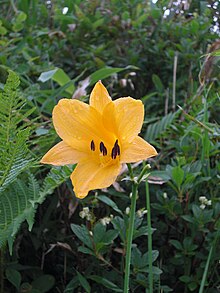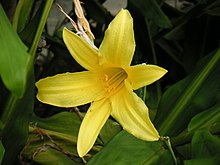Daylilies
| Daylilies | ||||||||||||
|---|---|---|---|---|---|---|---|---|---|---|---|---|

Yellow-red daylily ( Hemerocallis fulva ) |
||||||||||||
| Systematics | ||||||||||||
|
||||||||||||
| Scientific name | ||||||||||||
| Hemerocallis | ||||||||||||
| L. |
The daylilies ( Hemerocallis ) are a genus of plants that belongs to the subfamily of the daylily family (Hemerocallidoideae).
etymology
The scientific name of the genus comes from the Greek words Ἡμέρα (hēméra = day) and Κάλλος (kállos = beauty), as the individual flowers of the genus only bloom for a single day. The German name of the genus is derived from this fact .
description
Daylilies are perennial herbaceous plants . They often grow in clumps . The roots are often fibrous or fleshy and converging, but thickenings form at the ends from which rhizomes grow. The stem only has long linear leaves close to the ground , two of which are always facing each other. They are often bent and taper sharply towards the tip.
Typically, each plant bears two inflorescences that schraubelig cymoid are rarely occur florets.
The funnel-shaped, hermaphrodite and zygomorphic single flowers are short-lived for one day. The six bracts ( tepals ) are fused with short tubes at their base. The inner tepals are slightly wider than the outer ones. Each flower contains six stamens that are fused together at the base of the flower envelope . The stamens are bent upwards, separated and unequal. The dust bags consist of two halves (counters). Three fruit leaves are a top permanent dreifächerigen ovary grown, which is green. Nectaries are available. The upwardly curved stylus ends in a three-lobed or head-shaped scar.
Leathery capsule fruits are formed that contain either very few or many seeds.
distribution
Daylilies are found from Central Europe to East Asia . The genus Hemerocallis is absent from the New World ; although there are members of the daylily family in Australia , the genus seems to be absent there too. The diversity center is located with eleven species in the People's Republic of China , four species are endemic there . Since hybrids of the yellow-red daylily ( Hemerocallis fulva ) are particularly popular as garden plants, they can also be found in North American gardens and some of them have grown wild from there.




Systematics
For a long time the family, now the subfamily of the daylily family (Hemerocallidoideae), consisted exclusively of the genus Hemerocallis , the family / subfamily was greatly expanded. The genus name Hemerocallis was first published in 1753 by Carl von Linné in Species Plantarum , 1, p. 324. The type species is Hemerocallis lilioasphodelus L. To the genus Hemerocallis
-
Lemon Daylily ( Hemerocallis citrina Baroni), Origin: China (Schensi); with the varieties:
- Hemerocallis citrina var. Citrina
- Hemerocallis citrina var. Vespertina (H.Hara) M.Hotta
- Hemerocallis darrowiana SYHu
- Dumortier's day lily ( Hemerocallis dumortieri C. Morren), native to: Japan, Korea, Manchuria, Eastern Siberia
- Edible daylily ( Hemerocallis esculenta Koidz.), Origin: Japan, Sakhalin
- Hemerocallis exaltata stout
- Forrest's daylily ( Hemerocallis forrestii Diels), home: Jünnan
-
Yellow-red daylily ( Hemerocallis fulva (L.) L.), with the varieties:
- Hemerocallis fulva var. Angustifolia Baker
- Hemerocallis fulva var. Aurantiaca (Baker) M. Hotta (Syn .: H. fulva var. Sempervirens M. Hotta & M. Matsuoka)
- Hemerocallis fulva var. Fulva
- Hemerocallis fulva var. Kwanso rule
- Hemerocallis fulva var. Littorea (Makino) M.Matsuoka & M.Hotta
- Hemerocallis fulva var. Maculata Baroni
- Hemerocallis fulva var. Pauciflora M.Hotta & M.Matsuoka
- Hemerocallis hakuunensis Nakai
- Hemerocallis hongdoensis MGChung & SSKang
- Yellow daylily ( Hemerocallis lilioasphodelus L.), occurs in the southeastern Alps, in Italy and Slovenia and is naturalized in Europe, otherwise in Siberia, in the Amur region and in China
-
Middendorff's daylily ( Hemerocallis middendorffii Trautv. & CAMey.), Homeland: Amur region, northern China, Manchuria, Korea, Japan, Sakhalin; with the varieties:
- Hemerocallis middendorffii var. Longibracteata ZTXiong
- Hemerocallis middendorffii var. Middendorffii
- Small daylily ( Hemerocallis minor Mill.), Native to: Eastern Siberia, Mongolia, Northern China, Korea
- Multi-flowered daylily ( Hemerocallis multiflora Stout), Origin: China (Hunan)
- Dwarf daylily ( Hemerocallis nana WWSm. & Forrest), home: West-Jünnan
- Hemerocallis plicata Stapf
- Hemerocallis taeanensis SSKang & MGChung
- Thunberg's daylily ( Hemerocallis thunbergii Baker), native to: Korea, North China
- Hemerocallis yezoensis H. Hara
Culture

Daylilies are important as garden plants in Europe, the United States and especially in the People's Republic of China. In the United States alone, there are 38,000 registered daylily breeders who have produced over 13,000 named hybrids .
In the Chinese garden art is the genus for thousands of years of great importance. There the genus is valued for the edible flowers of some species and is used in traditional Chinese medicine . The cultivation in the People's Republic of China takes place mainly in the provinces south of the Qin Ling Mountains, mainly in the provinces of Hunan , Jianxi , Shaanxi , Sichuan and Gansu . The best-known growing area, which accounts for more than half of the national production, is in the Shaodong and Qidong counties in Hunan Province. In Taiwan , 391 tons of daylilies were harvested from 567 hectares of cultivated land in 2016. The main cultivation was in the districts of Hualien (287 t) and Taitung (59 t). Production has been declining for years.
The flowers are steamed and dried before human consumption. The consumption of untreated flower parts can cause symptoms of poisoning due to the alkaloid content . The leaves are used as roofing material in the construction of some types of traditional residential buildings in the Chinese province of Yunnan , Taichung , Taiwan, and Lan Yu Island .
Pests and diseases
Daylilies are generally quite robust. However, there are a few specific pests and diseases:
- Daylily gall midge (Hemerocallis gall midge, Contarinia quinquenotata )
- The Hemerocallis gall mosquito lays its eggs on the buds.
- The hatching larvae eat the flowers from the inside, whereby the flowers deform and usually do not open (see picture)
- Daylily rust
- Daylily rust was probably first noticed in the USA and introduced to Europe
- So far, cold winters have prevented the spread in Central Europe.
- Crown rot
- Excessive humidity and / or an unsuitable substrate encourage the plants to die off due to rot.
- It is characteristic that the leaves can be pulled off the rhizome.
Philatelic
On January 2, 2020, the first day of issue, Deutsche Post AG issued a postage stamp with the image of a daylily with a face value of 30 euro cents in the Flowers series . The design comes from the graphic designers Stefan Klein and Olaf Neumann from Iserlohn.
swell
- Entry in the Flora of North America . (English)
- Xinqi Chen, Prof. Song-Yun Liang, Jie-mei Xu, David E. Boufford, Michael G. Gilbert, Rudolf V. Kamelin, Shoichi Kawano, Tetsuo Koyama, Elena V. Mordak, Junko Noguchi, Victor G. Soukup, Hiroshi Takahashi, Kamilla G. Tamanian, Minoru N. Tamura & Nicholas J. Turland: Liliaceae in der Flora of China , Volume 24, p. 161: Hemerocallis - Online. (Section description, systematics)
literature
- Werner Rothmaler : Exkursionsflora von Deutschland Vascular Plants: Basic Volume , 18th Edition, Spectrum Akademischer Verlag, 2002, ISBN 3827413591 , page 503.
- Walter Erhardt : Hemerocallis - Daylilien , Verlag Eugen Ulmer, Stuttgart 1988, ISBN 3800163586 .
- Walter Erhardt : Hemerocallis - Daylilies , BT Batsford Ltd., London 1992, ISBN 0713470658 .
- Walter Erhardt among others: The big pikeperch. Encyclopedia of Plant Names . Volume 2. Verlag Eugen Ulmer, Stuttgart 2008. ISBN 978-3-8001-5406-7
Web links
- Society of Perennial Friends, Section Hemerocallis
- American Hemerocallis Society
- European Hemerocallis Society
Individual evidence
- ↑ Helmut Genaust: Etymological dictionary of botanical plant names. 3rd, completely revised and expanded edition. Nikol, Hamburg 2005, ISBN 3-937872-16-7 (reprint from 1996).
- ↑ 黄花菜 Hemerocallis citrina Baroni. www.eflora.cn (中国 高等植物 图鉴 - Higher Plants of China), accessed June 16, 2018 (Chinese).
- ↑ II 農業 生產 (I) 作物 生產 / Agricultural Production (I) Crop Production . In: Agriculture Council of the Executive Yuan (ed.): 105 年 農業 統計 年報 / Agricultural Statistics Yearbook 2016 . 2016, chapter 4. 蔬菜 (10) 金針菜 、 越 瓜 、 胡瓜 、 冬瓜 / 4. Vegetables (10) Day Lily, Oriental Pickling Melons, Cucumbers and White Gourds, S. 62–63 (English, Chinese, online ).
- ↑ Shan Deqi, E. Tang (transl.): Traditional Houses in China , China International Book Trading Corporation, 2004, ISBN 7-5085-0434-8
- ↑ Daylily rust on www.daylilies.org
- ↑ http://gds-hem-fachgruppe.homepage.t-online.de/gartnerisches.htm Homepage of the Hemerocallis section of the Society of Perennial Friends
- ↑ https://www.gartenlexikon.de/ Pflanzen/taglilien.html#h11-typische-krankheiten-pflegefehler-und-schaedlinge diseases and pests at www.gartenlexikon.de


